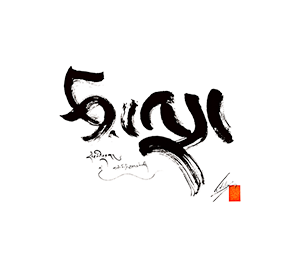Khenpo Ngawang Jorden at the 2019 Tathāgatagarbha Symposium
From Buddha-Nature
< Media
Khenpo Ngawang Jorden at the 2019 Tathāgatagarbha Symposium - 13 of 23
Video
Video
Description
Khenpo Ngawang Jorden discusses Gorampa’s interpretation of the concept of buddha-nature presented in his Supplement to the Three Vows. In particular his presentation is focused on Gorampa's refutation of the Jonang view of buddha-nature, as represented by the writings of Dolpopa and his zhentong philosophy.
Abstract from the Author
Revisiting Gorampa on Buddha Nature
I will share some of my thoughts and understanding of Go rams pa’s interpretation of the concept of buddha-nature presented in his Supplement to the Three Vows. This text was written to critique and clarify what Go rams pa saw as misrepresentations and misunderstandings of the theory of buddha-nature that were prevalent throughout Tibet in the fifteenth century. The Jo nang pa school of Tibetan Buddhism in particular was one of the major subjects of his criticism, whose assertions on buddha-nature he refuted, presenting and defending his own interpretations.
Sources Mentioned
A crucial source text for the Yogācāra school and many of its central tenets, including the theories of consciousness-only, all-ground consciousness (Skt. ālayavijñāna; Tib. kun gzhi rnam par shes pa), and the three natures. It is also noteworthy for its discussion of the relationship between the two truths (Ch.3), the three turnings of the wheel of Dharma (Ch.7), and meditation (Ch.8). Furthermore, it is commonly included in the Tibetan lists of sūtras that teach buddha-nature and/or the definitive meaning.
Saṃdhinirmocanasūtra;Bodhiruci; Paramārtha;Guṇabhadra;Xuanzang;Chen Hui (or Chen Yi);'phags pa dgongs pa nges par 'grel pa zhes bya ba theg pa chen po'i mdo;འཕགས་པ་དགོངས་པ་ངེས་པར་འགྲེལ་པ་ཞེས་བྱ་བ་ཐེག་པ་ཆེན་པོའི་མདོ།;Saṃdhinirmocanasūtra;解深密經;संधिनिर्मोचनसूत्र;འཕགས་པ་དགོངས་པ་ངེས་པར་འགྲེལ་པ་ཞེས་བྱ་བ་ཐེག་པ་ཆེན་པོའི་མདོ།
Dölpopa Sherab Gyaltsen: Mountain Dharma: An Ocean of Definitive Meaning
Dolpopa's seminal work considered to be the most definitive philosophical treatise of the Jonang tradition. It became famous as the crucial source for the presentation of his view of other-emptiness (zhentong).
Ri chos nges don rgya mtsho zhes bya ba mthar thug thun mong ma yin pa'i man ngag;Jonang;Dol po pa;zhentong;Dölpopa Sherab Gyaltsen;དོལ་པོ་པ་ཤེས་རབ་རྒྱལ་མཚན་;dol po pa shes rab rgyal mtshan;shes rab rgyal mtshan;shes rab mgon;rton pa bzhi ldan;ཤེས་རབ་རྒྱལ་མཚན་;ཤེས་རབ་མགོན་;རྟོན་པ་བཞི་ལྡན་;ri chos nges don rgya mtsho zhes bya ba mthar thug thun mong ma yin pa'i man ngag;རི་ཆོས་ངེས་དོན་རྒྱ་མཚོ་ཞེས་བྱ་བ་མཐར་ཐུག་ཐུན་མོང་མ་ཡིན་པའི་མན་ངག་;རི་ཆོས་ངེས་དོན་རྒྱ་མཚོ་ཞེས་བྱ་བ་མཐར་ཐུག་ཐུན་མོང་མ་ཡིན་པའི་མན་ངག
Maitreya: Madhyāntavibhāgakārikā
In Sanskrit, “Differentiation of the Middle Way and the Extremes”; one of the Five Dharma Treatises of Maitreya (byams chos sde lnga) said to have been presented to Asaṅga by the bodhisattva Maitreya in the Tuṣita heaven. Written in verse, it is one of the most important Yogācāra delineations of the three natures (trisvabhāva), especially as they figure in the path to enlightenment, where the obstacles created by the imaginary (parikalpita) are overcome ultimately by the antidote of the consummate (pariniṣpanna). The “middle way” exposed here is that of the Yogācāra, and is different from that of Nāgārjuna, although the names of the two extremes to be avoided—the extreme of permanence (śāśvatānta) and the extreme of annihilation (ucchedānta)—are the same. Here the extreme of permanence is the existence of external objects, the imaginary nature (parikalpitasvabhāva). The extreme of annihilation would seem to include Nāgārjuna’s emptiness of intrinsic nature (svabhāva). The middle way entails upholding the existence of consciousness (vijñāna) as the dependent nature (paratantrasvabhāva) and the existence of the consummate nature (pariniṣpannasvabhāva). The work is divided into five chapters, which consider the three natures, the various forms of obstruction to be abandoned on the path, the ultimate truth according to Yogācāra, the means of cultivating the antidotes to the defilements, and the activity of the Mahāyāna path. (Source: The Princeton Dictionary of Buddhism, p. 489)
RKTST 3360;byams chos sde lnga;Maitreya;བྱམས་པ་;byams pa;'phags pa byams pa;byams pa'i mgon po;mgon po byams pa;ma pham pa;འཕགས་པ་བྱམས་པ་;བྱམས་པའི་མགོན་པོ་;མགོན་པོ་བྱམས་པ་;མ་ཕམ་པ་;Ajita; Jinamitra;ཇིནམིཏྲ;slob dpon dzi na mi tra;Śīlendrabodhi;shi len+d+ra bo d+hi;tshul khrims dbang po byang chub;Yeshe De;ཡེ་ཤེས་སྡེ་;ye shes sde;sna nam ye shes sde;zhang ban+de ye shes sde;སྣ་ནམ་ཡེ་ཤེས་སྡེ་;ཞང་བནྡེ་ཡེ་ཤེས་སྡེ་;Xuanzang;Chen Hui (or Chen Yi);dbus dang mtha' rnam par 'byed pa'i tshig le'ur byas pa;དབུས་དང་མཐའ་རྣམ་པར་འབྱེད་པའི་ཚིག་ལེའུར་བྱས་པ།;Madhyāntavibhāgakārikā;辯中邊論頌;དབུས་དང་མཐའ་རྣམ་པར་འབྱེད་པའི་ཚིག་ལེའུར་བྱས་པ།
People Mentioned
About the video
| Featuring | Khenpo Ngawang Jorden |
|---|---|
| Creator | University of Vienna, Tsadra Foundation |
| Event | Tathāgatagarbha Across Asia (18 July 2019, University of Vienna, Austria) |
| Related Website | Buddha-Nature Project |
| Video Web Location | Tathāgatagarbha Across Asia |
| Creation Date | 18 July 2019 |
| Citation | Jorden, Khenpo Ngawang. "Revisiting Gorampa on Buddha Nature." Paper presented at the University of Vienna Symposium, Tathāgatagarbha Across Asia, Vienna, Austria, July 2019. Video, 45:05. https://www.youtube.com/watch?v=wmhgtw5HwCE. |
